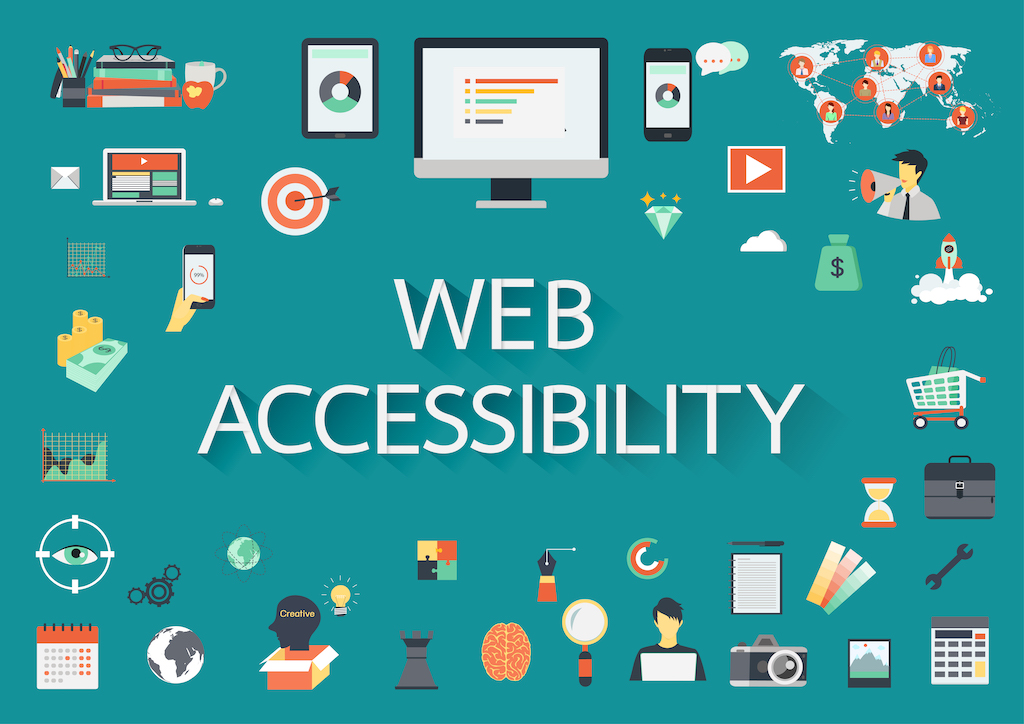Website accessibility ensures that all users, including people with disabilities, can understand and engage with the information on your website. Taking the time to analyze and update your website will provide users a pleasant experience. While some things require knowledge of coding, this article will focus on the top issues TwoSix Digital sees regularly and provide solutions that anyone with abilities can easily accomplish. Below are the 7 things you can do to make your website more accessible.
1.) Avoid “Click Here” (User-Friendly Link Text)
 Consider using a Voice Directed application to click on a link that reads “click here” — “click click here”. That could easily become very frustrating and confusing. Avoid hyperlink words such as “click”, “here”, “more”, details”, “link”, “continue”, or “button”. Links reading “click here” or “read more” can also make users feel like they’re being baited to click. Instead, link text should be concise and tell the user exactly what they’re clicking on. Directional language can be used but shouldn’t be hyperlinked. For instance, discover “10 Things Your Tourism Website Needs”.
Consider using a Voice Directed application to click on a link that reads “click here” — “click click here”. That could easily become very frustrating and confusing. Avoid hyperlink words such as “click”, “here”, “more”, details”, “link”, “continue”, or “button”. Links reading “click here” or “read more” can also make users feel like they’re being baited to click. Instead, link text should be concise and tell the user exactly what they’re clicking on. Directional language can be used but shouldn’t be hyperlinked. For instance, discover “10 Things Your Tourism Website Needs”.
2.) Don’t Link to PDFs
Unless they’re created expressly with accessibility in mind, PDF documents typically have issues. Plus, PDFs usually open in a separate application, which can cause problems when switching between browser and app. Instead, just make that PDF into a webpage! If the PDF is a requirement, inform the user that the link will open a PDF and make it accessible (tip: it ends up being the same things you would do to make a web page accessible, such as alternative text).
3. Contrast: It’s Not Enough!
Creating contrast on your website is an important factor for user accessibility. While a white font on a light gray background may look good on your computer, it could be hard to read for some users on your website. Try testing your website’s colors with this free contrast checker or find a color with this contrast finder. You may ask: what about our branding? We would argue everyone being able to read your website is more important. But, like the way some websites have a language switcher, you could have a contrast switcher for those that need it. Contrast also grabs the reader’s attention; making it worthwhile to include contrast for important elements on your website, too.
4.) Font Size & Type
The font size and type you use on your website will determine successful layouts and readability. In terms of size, 12 point or 16px is often quoted as the accessible minimum for websites. This includes the body text, not headings and other text that should stand out more. As for the type of font, more than three different fonts will look unprofessional and disrupt your branding. Whichever font size and type you use, stay consistent throughout your website, and be sure it’s readable to your audience.
5.) Alternative Text on Images (Add Descriptions)
Images provide lots of benefits on websites from catching someone’s attention or triggering an emotion. For those with visual impairments, it’s imperative to ensure you have alt text descriptions on so they can understand what is happening in the image. Be as detailed as possible in the description for the alt text. There are plenty of other benefits of alt text, such as SEO improvements. When a page is loading slowly, alt text will display where the image is supposed to be and explain what’s supposed to be there. Below is a good and bad example of alt text descriptions for this photo. Note how the more specific one will enhance your SEO.

Bad: “Baseball player hitting a ball at a baseball field.”
Good: “Miguel Cabrera of the Detroit Tigers batting at home plate at Comerica Park.”
6.) Form Labels
When creating areas for users to input answers, such as a form, having a descriptive label explaining what exactly is needed in the field is vital. Without form labels, someone with disabilities using a screen reader, would not be able to navigate to it or know what is needed in the area. Wherever users are asked to provide details on your website, be sure to have clear labels before or near the empty field.
7.) Headings
Headings allow users to understand what the contents of the page will entail. For users with disabilities, they help them navigate through a website. Be sure you structure them properly, with distinct levels such as H1, H2, H3, and so on. In this way, headings also create organization for your website, giving every important topic its own space or page. Note: be sure to only include one H1 heading for each webpage.
Following these tips and using the WAVE® Web Accessibility Evaluation Tool will help you create or update your website to be accessible to individuals with disabilities. Be sure to check out our other blogs.

